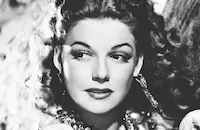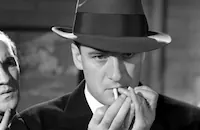They Made Me a Criminal

Brief Synopsis
Cast & Crew
Busby Berkeley
John Garfield
Claude Rains
Gloria Dickson
May Robson
Billy Halop
Film Details
Technical Specs

Synopsis
Johnnie Bradfield, a deadly and cynical prize fighter, has just slugged his way to the championship when, during a drunken brawl in his apartment, his manager, Doc Wood, accidentally kills Magee, a newspaper reporter, and fixes the evidence so it appears that Johnnie has done the deed. Doc then makes his getaway, but perishes in a car accident while wearing Johnnie's watch. The next morning, Johnnie awakens in a strange place and reads a newspaper article informing him that he has perished in a car wreck after murdering a reporter. On the advice of a shady lawyer, the champ flees, changes his identity and becomes an outcast. He lands in Arizona, where he casts his lot with Grandma, who runs a date ranch with the help of Peggy and the Dead End Kids. The Kids have been sent from New York by a kindly priest who wants to rehabilitate the boys. At the ranch, the regeneration of the boxer begins as Peggy helps him to fight his inborn tendency to believe that everyone is a sucker and the world has it in for him. Johnnie's salvation comes when he enters a local fight ring to win some money so that he can help his friends open up a filling station. Meanwhile, New York detective Phelan cleverly picks up Johnnie's trail and tracks him to ringside where he is fighting a heavyweight. As Johnnie slugs his heart out for his friends, the detective begins to reflect and, realizing that the fighter has been punished enough, returns to New York without his prisoner.

Director

Busby Berkeley
Cast

John Garfield

Claude Rains

Gloria Dickson

May Robson

Billy Halop

Bobby Jordan

Leo Gorcey

Huntz Hall

Gabriel Dell

Ann Sheridan
Robert Gleckler

John Ridgely

Barbara Pepper

William Davidson

Ward Bond
Robert Strange

Louis Jean Heydt
Frank Riggi
Cliff Clark
Dick Wessel
Raymond Brown
Sam Hayes
Bernard Punsley

Ronald Sinclair

Irving Bacon
Sam Mcdaniel
Bert Roach
Charles Randolph
Larry Mcgrath
Mushy Callahan
Janet Shaw
Sally Sage
John Harron
Georgie Cooper
Joe Cunningham
Richard Bond
Nat Carr
Reid Kilpatrick
Jack Austin
Frank Meredith
Ed Brian
Hal Craig
Eddy Chandler

Elliott Sullivan
Jack Wise

Clem Bevans
Nat Carr
Bob Perry

Tom Wilson
Stuart Holmes
Charles Sullivan
John Dilson
Dave Roberts

Doris Lloyd
Leyland Hodgson
Dorothy Varden
Donald Kerr

Jack Mower
Cliff Saum
Al Lloyd
Frank Mayo
Tom Dugan

Arthur Housman
John Sheehan
Crew

Photo Collections
Film Details
Technical Specs

Articles
They Made Me a Criminal
--Tag line for They Made Me a Criminal
John Garfield was promoted to leading man at Warner Bros. with They Made Me a Criminal in 1939. And though his image as the doomed loner had been established with his contract debut the previous year as the moody composer in Four Daughters (1938), the title They Made Me a Criminal was a more accurate reflection of his screen image. Here was a story that had all the essential ingredients for a Depression era hit -- boxing, murder, a dogged detective (Claude Rains) out to catch the suspected killer and a troop of good-hearted delinquents who needed Garfield's stern guidance to shape up.
With Garfield's success in Four Daughters, Warner Bros. dusted off the script from an earlier film, The Life of Jimmy Dolan (1933), which had originally starred Douglas Fairbanks, Jr. as a boxer who fakes his death when he's wrongly fingered for murder. The studio had originally considered the re-make for Errol Flynn, but when he scored solidly in Captain Blood (1935) and other costume swashbucklers, they decided to use him primarily in period pictures. Garfield's rapid rise at the studio gave them a second chance to remake the earlier film.
There was only one snag in the studio's plans. After Four Daughters, they had rushed Garfield into a low-budget film called Blackwell's Island (1939) simply to keep him busy. But now they didn't want him to follow his first triumph with a B film. Studio head Jack Warner halted distribution just as Blackwell's Island was on the way to theatres as a second feature. He put the film back into production with his favorite studio director, Michael Curtiz, shooting new scenes on an increased budget. The schedule was so tight that Garfield had to do re-takes in the morning, then work on They Made Me a Criminal in the afternoons.
Garfield, who had gotten his start with New York's prestigious Group Theatre, was none too happy to learn that the studio had assigned choreographer Busby Berkeley to direct the film. Declining box office had recently led Warners to cut back on its string of big-budget musicals, which had become hits thanks largely to Berkeley's inventive dance direction. He had been directing non-musical films between song-and-dance assignments and had developed a reputation for working quickly and sticking to a budget. What were virtues to the front office, however, caused Garfield some concern. He was afraid Berkeley would rush through the filming, giving him little chance to develop the character.
His fears were unfounded. Berkeley kept things moving, but also stayed out of Garfield's way. And his experience as a dance director made him a natural for the boxing scenes. Working with cameraman James Wong Howe, he created fight scenes that wouldn't be surpassed until Howe shot another Garfield picture, Body and Soul, in 1947. The staging was so convincing that when a real estate agent and his client wandered onto the location set in Burbank, they thought they were watching the real thing. Berkeley's accomplishments didn't lead to a new career at Warners, however. They Made Me a Criminal marked the end of his contract there before he moved on to MGM, where a new generation of musical stars, including the young Mickey Rooney and Judy Garland, were waiting to take the genre in new directions.
Berkeley had to move fast during location shooting in Palm Desert, especially while filming the scenes on the farm where Garfield hides out. The cast and crew had to cover their heads and torsos with netting between shots to protect themselves from gnats, which swarmed constantly. Temperatures rose so high in the afternoon that cast members passed out. Eventually, they had to do all their shooting in the morning. The afternoon temperatures were so high they would have melted the film in the cameras.
Garfield had a particularly good time working with the Dead End Kids, a group of young New York actors -- including Billy Halop, Bobby Jordan, Leo Gorcey and Huntz Hall -- who had come to Hollywood to re-create their stage roles in the film version of Dead End (1937). Although the group could be a handful, they got on well with Garfield since their lower-class backgrounds and stage experience were very similar. After three more films at Warners, they would splinter and move on to other studios, with Gorcey and Hall re-surfacing as The Bowery Boys in a series of low-budget comedies at Monogram Pictures.
Garfield also enjoyed both of his leading ladies, Ann Sheridan and Gloria Dickson. Both were romantically linked with their leading man, a situation that would recur throughout his career. Sheridan would go on to become one of the studio's biggest stars, while Dickson, who had made a strong debut in Warner's They Won't Forget (1937), would die tragically a few years later in a house fire.
They Made Me a Criminal opened in January 1939 to solid reviews, with Garfield attracting most of the strong notices. The film's strong performance at the box office proved that the star was indeed a box office name. When Blackwell's Island came out shortly afterwards, it met with a similar response, clearly establishing Garfield as one of Warner's top stars.
Producer: Benjamin Glazer
Director: Busby Berkeley
Screenplay: Sig Herzig
Based on the play Sucker by Bertram Millhauser, Beaulah Marie Dix
Cinematography: James Wong Howe
Art Direction: Anton Grot
Music: Max Steiner
Cast: John Garfield (Johnny Bradfield/"Jack Dorney"), Gloria Dickson (Peggy), Claude Rains (Detective Monty Phelan), Ann Sheridan (Goldie), May Robson (Gramma), Billy Halop (Tommy), Bobby Jordan (Angel), Leo Gorcey (Spit), Huntz Hall (Dippy), Gabriel Dell (T.B.), Barbara Pepper (Budgie), Ward Bond (Lenihan).
BW-92m. Closed captioning.
by Frank Miller

They Made Me a Criminal
Quotes
Trivia
Desert location shooting was so hot at times that the film melted in the camera.
Claude Rains at first turned down the part, feeling he would be miscast, and look ridiculous, as a slovenly, tough, obsessed cop. Only after being threatened by the studio with suspension did he reluctantly accept it, but he always considered this one of his least favorite pictures.
The play opened off-broadway in New York City, New York, USA on 4 April 1933.
Notes
According to a news item in Hollywood Reporter, Warner Bros. executives decided to add several scenes to boost the production values of this film after watching a rough cut. The picture marked John Garfield's first starring role in films. In 1933, First National produced The Life of Jimmy Dolan, the first screen version of the Bertram Millhauser-Beulah Marie Dix play. Actors Billy Halop, Bobby Jordan, Leo Gorcey, Huntz Hall and Gabriel Dell were featured in Warner Bros.' "The Dead End Kids" films. Although their character names were different in those films, their characterizations in They Made Me a Criminal were similar. For additional films featuring these actors, see entry above for Crime School and consult the Series Index under "The Dead End Kids," "The East Side Kids" and "The Little Tough Guys."















